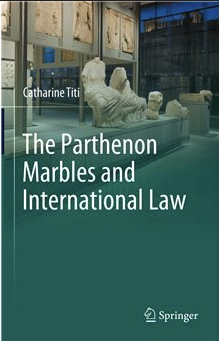- Université
- Formations
- Recherche
- International
- Campus
The Parthenon Marbles and International Law
The Parthenon Marbles and International Law

Auteur(s)
Catharine TITI
Date de parution
05/2023
Éditeur
Springer
ISBN
978-3-031-26356-9
Langue de la publication
Anglais
Nombre de pages
331
Résumé
Le différend entre la Grèce et le Royaume-Uni concernant la restitution des marbres du Parthénon exposés au British Museum est le plus connu des différends internationaux en matière d’antiquités pillées. Il a divisé l’opinion publique depuis qu’un diplomate britannique, Lord Elgin, a fait arracher les marbres de l’ancien temple au tournant du XIXe siècle à Athènes, qui se trouvait à l’époque sous occupation ottomane, pour les envoyer à Londres. En 1816, criblé de dettes, Elgin s’est vu obligé de les vendre au gouvernement britannique, qui les a confié au British Museum, où ils sont désormais exposés. Cet exil forcé des marbres du Parthénon a suscité de nombreuses polémiques et débats. Cependant, les arguments juridiques relevant du droit international en faveur de leur retour n’ont jamais été pris en compte. Pour la première fois, un ouvrage examine ce différend au regard des exigences du droit international et apporte un éclairage sur le nouveau cadre juridique de la protection du patrimoine culturel.
***
The Parthenon marbles case is the most famous international cultural heritage dispute concerning repatriation of looted antiquities, the Parthenon marbles in the British Museum’s ‘Elgin Collection’. The case has polarised observers ever since Elgin had the marbles hacked out of the ancient temple at the turn of the 19th century in Ottoman-occupied Athens. In 1816, a debt-stricken Elgin sold the marbles to the British government, which subsequently entrusted them to the British Museum, where they have remained since then.
Much ink has been spilled on the Parthenon marbles. The ethical and cultural merits of their repatriation have been fiercely debated for years. But what has generally not been considered are the legal merits of their return in light of contemporary international law. This book is the first in legal scholarship to provide an international law perspective of the cause célèbre of international cultural heritage disputes and, in doing so, to clarify the new customary international law on the return of cultural property unlawfully removed from its original context.
The book is a unique reference work on the legal case for the return of the Parthenon marbles and the new normative framework for the protection of cultural heritage.
